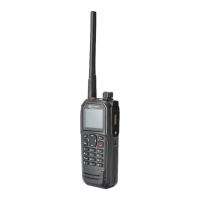DP770 Service Manual
3.1.2. Receiver Circuit
Figure 3-3 Receiver Circuit Diagram
T
he receiver circuit mainly comprises RF band-pass filter, low-noise amplifier, mixer, IF filter, IF amplifier
and IF processor.
• Receiver Front-end
The HF signal from the low-pass filter passes through the electrically tunable band-pass filter controlled via
APC/TV1 level, to remove out-of–band interference signal and to send wanted band-pass signal to the
low-noise amplifier (UHF:Q205,VHF:Q62). The amplified signal goes to a band-pass filter controlled via
TFV level to remove out-of-band interference signal generated during amplification, and to send wanted HF
signal to the mixer (UHF:Z201,VHF:Z10).
Meanwhile, the first local oscillator signal generated by VCO passes through the low-pass filter and also
goes to the mixer (UHF: Z201, VHF: Z10). In the mixer, the wanted signal and the first local oscillator are
mixed to generate the first IF signal (UHF: 73.35MHz, VHF: 51.65MHz). The signal passes a frequency
selective network composed of LC, to suppress carrier other than the first IF signal, and to increase the
isolation between the mixer and the IF filter. After that, the first IF signal is processed by the crystal filter
(UHF: Z202, VHF: Z11) and is sent to the two-stage IF amplifier circuit composed of 2SC5006 for
amplification. Then the amplified signal goes to the IF processor AD9864 (UHF: U201, VHF: U91) for
processing.
• eceiver Back-end
Figure 3-4 IF Processor Diagram

